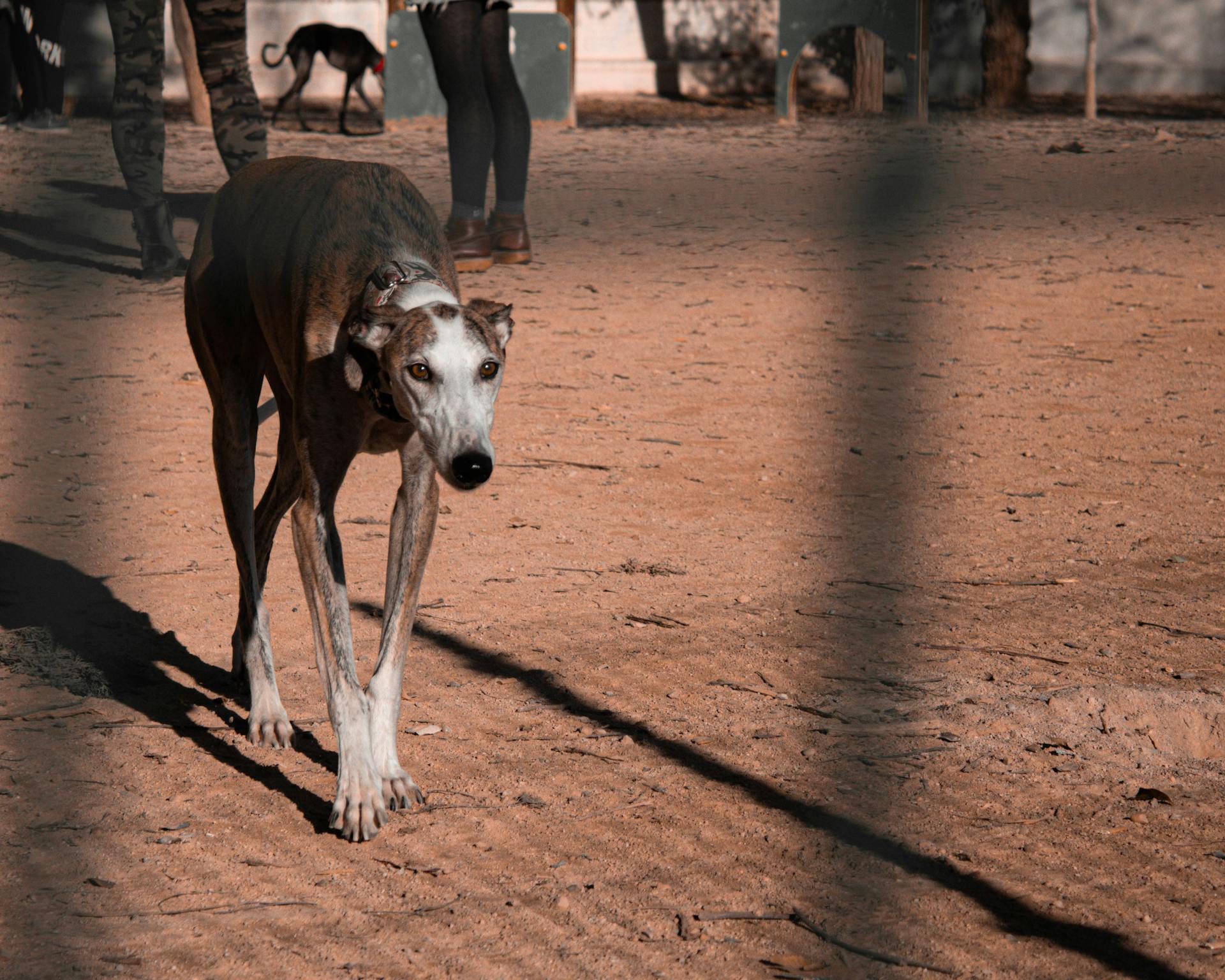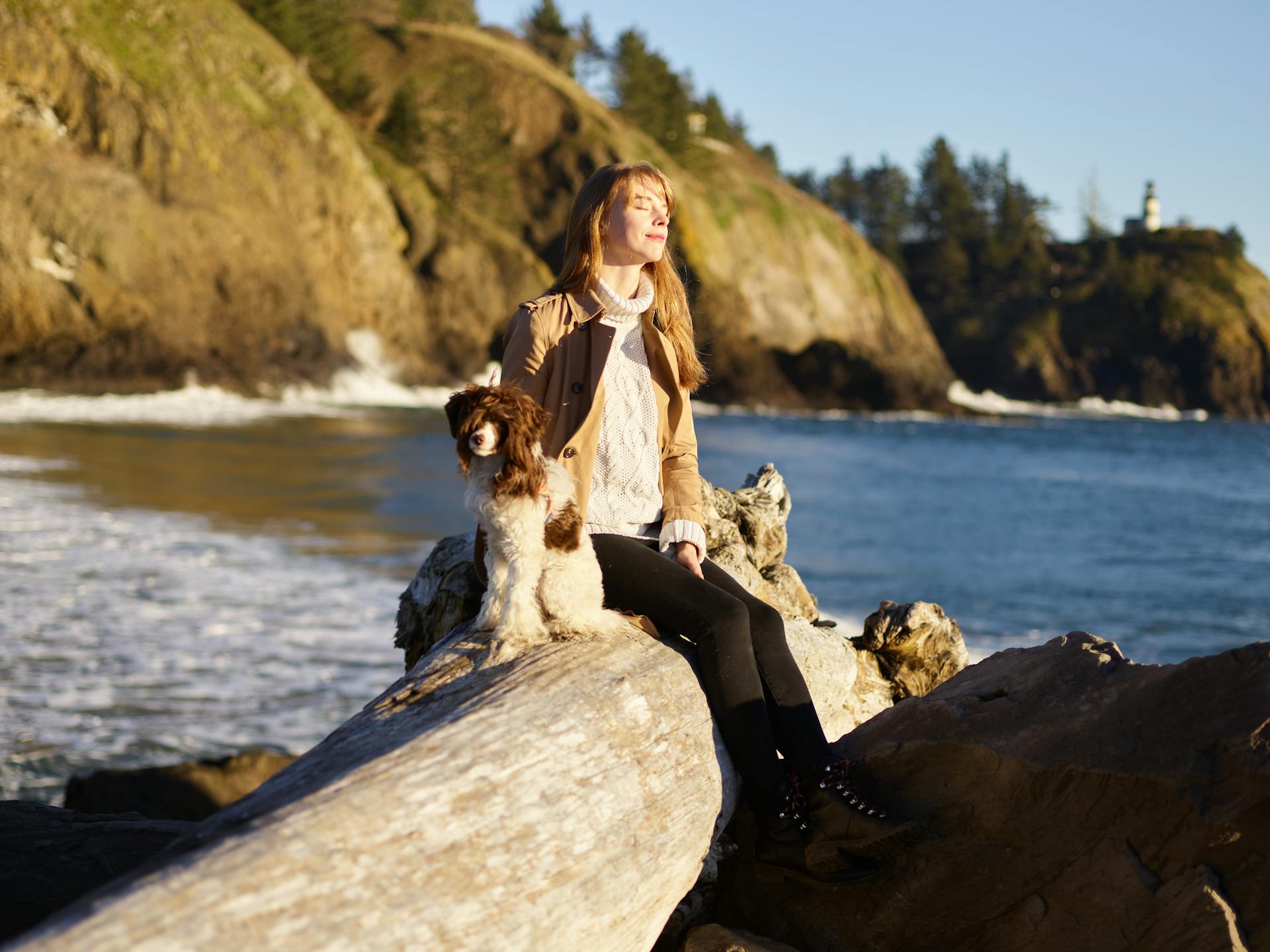
Spanish dog breeds are known for their rich history and diverse characteristics. The country's unique geography and climate have shaped the development of its canine population.
From the mountains to the coastlines, Spanish dog breeds have adapted to various environments and purposes. Some breeds, like the Perro de Presa Canario, were bred for guarding and working.
The Perro de Presa Canario, for example, is a powerful and loyal breed that originated on the island of Gran Canaria. This breed's distinctive features include its muscular build and short, smooth coat.
Spanish Dog Breeds
Spanish Dog Breeds are known for their unique characteristics and temperaments, shaped by their origins and history in Spain.
The Perro de Presa Canario, also known as the Canary Mastiff, is a large and powerful breed that was originally bred to guard and protect livestock.
This breed is known for its loyalty and protective nature, making it an excellent watchdog.
The Perro de Presa Canario is a relatively rare breed, but it's gaining popularity in recent years due to its loyal and loving personality.
The Galgo Español, also known as the Spanish Greyhound, is a sleek and agile breed that was bred for hunting small game.
This breed is known for its incredible speed and endurance, making it a popular choice for hunters and dog enthusiasts alike.
The Galgo Español is a relatively low-maintenance breed, requiring regular exercise and grooming to stay healthy and happy.
The Podenco Canario, also known as the Canary Island Dog, is a medium-sized breed that was originally bred to hunt small game and protect livestock.
This breed is known for its intelligence and independence, making it a great choice for active and experienced dog owners.
The Podenco Canario is a relatively rare breed, but it's gaining popularity in recent years due to its unique appearance and loving personality.
Readers also liked: Airedale Dog Characteristics
Personality and Temperament
The Spanish Water Dog is a bright, intelligent, and friendly breed that thrives on work and activity. They love to be part of a family group and can become strongly bonded to one person, but they're also gregarious and enjoy being around their people.
This breed is highly intelligent and easy to train, but they do require a firm owner who can take charge and fill the role of pack leader. They're not suited for novice dog owners who may struggle to keep up with their high energy levels.
Spanish Water Dogs are wonderful family dogs that do well with children, but they may try to herd them as part of their herding ancestry. Early socialization with people and other animals is key to preventing protectiveness and ensuring they're well-adjusted.
With proper training and exercise, Spanish Water Dogs can be loyal and loving companions. They're highly affectionate, but they also need frequent stimulation to prevent boredom and destructive behavior.

As a breed that's prone to barking at strangers, Spanish Water Dogs may not be the best fit for homes with frequent guest arrivals. However, they're generally great with other pets, especially cats, as long as they're introduced properly.
Overall, Spanish Water Dogs are intelligent, active, and loving companions that thrive on work, play, and family time.
Care and Maintenance
The Spanish Water Dog is a low-maintenance breed when it comes to coat care, as it should never be brushed.
To keep their coat in check, they need to be sheared at least once a year, historically done at the same time as sheep shearing.
Daily exercise is a must for this breed, but they also relax easily indoors, making them suitable for apartment or urban living.
Their coat can handle frequent contact with water, but it's essential to towel blot it dry instead of rubbing or towel drying.
Regular nail trimming, ear cleaning, and teeth brushing are also crucial for their overall health and well-being.
Spanish Water Dogs are considered hypoallergenic due to their single coat that sheds minimally, but no dog breed is 100% hypoallergenic.
Nutrition and Feeding

The Spanish Water Dog needs a balanced diet including all main nutrient groups and a constant supply of fresh water. This is crucial for their overall health and well-being.
You should conduct regular body condition scores to ensure your dog stays in ideal shape. This will help you monitor their weight and adjust their diet accordingly.
Feeding your Spanish Water Dog at least twice daily is recommended. This ensures they're getting the nutrients they need throughout the day.
Follow the feeding guidelines of their particular food to avoid overfeeding or underfeeding. This will help you provide the right amount of food for your dog's specific needs.
Intriguing read: German Shorthaired Pointer Feeding Chart
Breed Maintenance
The Spanish Water Dog is a low-maintenance breed when it comes to its coat, which should never be brushed.
Their coats can handle frequent contact with water, but it's essential to towel blot the coat and never towel dry or rub it to prevent matting.
You may need to bathe your Spanish Water Dog, especially if they get dirty or develop knots or mats in their coat.
Removing knots and mats requires working from the top down with your fingers, and it's crucial to assist the cording to prevent matting at the skin.
At least once a year, you should shear the Spanish Water Dog to prevent matting and keep their coat healthy.
Historically, Spanish Water Dogs were sheared at the same time as the sheep, and their coats were designed to adapt to the humid and dry weather in the Iberian Peninsula.
The Spanish Water Dog is a very active breed and requires daily exercise, but they can relax easily indoors and make great apartment or urban living dogs.
Their versatility and flexibility in different climates make them an excellent choice for many owners.
The amount of food your Spanish Water Dog needs will depend on their size, age, metabolism, and activity levels, so it's essential to pay close attention to their nutritional health and adjust their diet as needed.
Spanish Water Dogs can suffer from several health issues, so securing pet health insurance is a good idea to avoid high veterinary care costs.
Take a look at this: Why Are Labrador Retrievers so Popular
Training and Behavior
The Spanish Water Dog is a highly trainable breed that thrives on positive reinforcement and mental stimulation.
They're naturally eager to please and smart, making them one of the easier breeds to train.
Early training from a young age is beneficial, but older rescue dogs can also take well to training with the right approach.
Positive training has the best success rate, so use treats and praise instead of punishment or yelling.
Short and precise commands work best, such as "sit", "wait", and "leave it" instead of lengthy lectures.
If you're having challenges, consider seeking help from a professional trainer or a veterinarian who can refer you to one.
Additional reading: One Eye Shih Tzu
Interesting Facts
The Spanish dog breeds are a treasure trove of unique characteristics and abilities. Some of these breeds are naturally good at herding, such as the Pyrenean Mastiff, which is known for its strong instincts and protective nature.
The Spanish Water Dog is another breed that's highly intelligent and energetic, requiring regular exercise and mental stimulation to prevent boredom and destructive behavior.
This breed is also highly versatile, exceling in various roles such as hunting, herding, and even serving as a loyal companion.
Similar Breeds
If you're considering a Spanish Water Dog but aren't sure if it's the right fit for your family, there are several similar breeds worth exploring.
One breed that's often compared to the Spanish Water Dog is the Border Collie. They're known for being playful and friendly, making them a great choice for families with young children.
The German Shepherd is another breed that shares some similarities with the Spanish Water Dog. They're highly intelligent and often work as search and rescue dogs.
The Shetland Sheepdog, also known as a Sheltie, is a herding breed that's similar to the Spanish Water Dog in many ways. They're loving towards their families but may be wary of strangers.
Here are a few breeds to consider:
- Border Collie: playful, friendly, and serves as search and rescue dogs
- German Shepherd: iconic working dog, good with young children
- Shetland Sheepdog: loving towards families, may be wary of strangers
Specific Breeds
Some Spanish dog breeds are known for their distinctive features and characteristics. The Perro de Presa Canario, for instance, is a large and powerful breed that originated in the Canary Islands.
This breed is often described as confident, courageous, and loyal. They are also known for their short, smooth coats that require minimal grooming.
The Perro de Presa Canario is a relatively rare breed, but it's gaining popularity among dog enthusiasts.
Breed History
The Spanish Water Dog is considered the oldest of all the Water Dogs, with its origins shrouded in mystery.
Many believe the breed is from an ancient line, with some thinking it was brought to Spain from Turkey and Hungary, while others believe it arrived from Northern Africa via the Moors during the 8th century.
The breed developed in relative obscurity in the Andalusian region of Spain over a millennium, with its primary role being herding rather than water work.
This versatile dog is capable of water work, search and rescue, and hunting, in addition to its excellent herding skills.
The breed was unknown outside of Andaluz, Spain until 1975, when fanciers brought it out of obscurity and introduced it to the world as a rare breed.
In 1985, the Spanish Water Dog was recognized by the Real Sociedad Central de Fomento de Razas Caninas en Espana, and by 2008, it was accepted into the miscellaneous breed category.
Today, the Spanish Water Dog is mostly seen in the show-ring, but it retains an all-rounder attitude to a variety of jobs and is a bright, intelligent dog who can make a fun companion if its grooming needs are not an issue.
Gos Rater Valencia
The Gos Rater Valencia is a unique dog breed that originated in Valencia, Spain. They are bred to hunt down rats and rabbits, and their independent nature means they spend most of their time outdoors.
Their lifespan is impressive, lasting between 11 and 14 years. This breed is not as house-friendly as others, making them a better fit for families who have a lot of outdoor space.
Their weight can vary, ranging from 9 to 18 pounds, making them a relatively small dog. They have a strong instinct to hunt, which can be a challenge for owners who don't provide them with adequate exercise and stimulation.
Their coat type is not specified, but it's likely to be one of the three types mentioned for the Valencian Podenco: smooth, silky, or rough. They were bred to be useful on ranches and farms, where they can perform various tasks.
In 2011, the Gos Rater Valencia won the Spanish National Dog Show, a testament to their hunting prowess and unique characteristics.
Intriguing read: How to Train a German Shorthaired Pointer to Hunt
Mastiff
The Mastiff breed is known for its massive size and loyal nature. They were developed to protect livestock, so it's no surprise they have a strong instinct to guard.
The Spanish Mastiff and Pyrenean Mastiff are two examples of Mastiff breeds that originated in Spain. The Spanish Mastiff weighs between 110-220 pounds and has a lifespan of 10-12 years.
These gentle giants are perfect for families with kids, as they are patient and laid-back. They make great family pets because they are loyal and calm around their human companions.
Here's a comparison of the two breeds:
Both breeds have a blocky head and muscular frame, which is perfect for their original job of protecting livestock. They are also adaptable to different home environments, making them a great choice for many families.
Recommended read: Dogs Breeds That Start with B
Ibizan Hound
The Ibizan Hound is a breed that originated off the coast of Spain, on the island of Ibiza. They have a lifespan of 11 – 14 years.
One of the distinctive features of the Ibizan Hound is their weight, which can range from 45 – 65 pounds. This makes them a medium-sized dog.
The Ibizan Hound has a long history, with traders importing them to Spain around 3,000 years ago.
Curious to learn more? Check out: Bull Terrier 100 Years Ago
Presa Canario
The Presa Canario is a breed that originated in the Canary Islands. They have a relatively short lifespan of 9 – 11 years.
This breed is known for being protective yet family-oriented, making them a great companion for the right owner. Their weight range is quite substantial, coming in at 85 – 140 pounds.
Unfortunately, there are only a few Presa Canarios in existence today, which is a concern for experts. Fortunately, they are adaptable to a variety of living situations, making them a great choice for many families.
Pachon Navarro
The Pachon Navarro is a rare breed with a rich history. They originated in Navarre, Spain.
Their lifespan is relatively long, ranging from 12 to 15 years. This makes them a great companion for many families.
Their weight is typically between 55 and 70 pounds, making them a sturdy but not overly large breed.
Their short, smooth hair is easy to groom and manage, which is a big plus for busy owners.
Alano Espanol
The Alano Espanol is a breed with an unclear origin, though it's believed that its ancestors were imported into Spain during the 5th century.
This breed has a lifespan of 11 – 14 years, which is a decent amount of time to form a strong bond with your pet.
The Alano Espanol is a muscular dog with a dark coat and markings all over, weighing in at 55 – 90 pounds.
They can make great guard dogs and property protectors, but they're also sociable and friendly unless they feel threatened.
Ratonero Bodeguero Andaluz
The Ratonero Bodeguero Andaluz is a small but spunky Spanish dog breed that's perfect for households with a lot of energy. They were developed to hunt rats and have a unique temperament that sets them apart from other breeds.
Originating from the Marco de Jerez in the south of Spain, this breed has a lifespan of 15-18 years, which is impressive for a dog of its size. They typically weigh between 12-22 pounds, making them a great choice for families who want a compact companion.
One of the standout features of the Ratonero Bodeguero Andaluz is their high energy level, which means they need regular exercise to keep them happy and healthy. They're not as big as some other breeds, but they're certainly not lazy!
Here's a quick rundown of the breed's key characteristics:
Overall, the Ratonero Bodeguero Andaluz is a wonderful breed for anyone looking for a small but lively companion.
Majorero
The Majorero is a breed that originated in the Canary Islands, specifically on the island of Fuerteventura.
They have a relatively long lifespan, living for 11-12 years.
Their weight can vary, ranging from 55 to 100 pounds.
This breed is known to be protective of their human companions and can make great guard dogs with proper training.
They can also help protect livestock on farms.
The Majorero comes in two colors: blonde and black.
Their playful and curious nature makes them a great fit for families with children.
Majorca Shepherd
The Majorca Shepherd is a fantastic breed that originated in the Majorca area and throughout Spain. They have a lifespan of 12 – 13 years.
These dogs are known for their entirely black coat, which is quite striking. They also have a Labrador-like face that's endearing to many people.
The Majorca Shepherd typically weighs between 75 – 90 pounds, making them a sturdy breed.
Suggestion: Majorca Shepherd Dog
Multi-Sensory Specialised Hunters
The Podenco breed is a great example of a multi-sensory specialised hunter. They have large, highly-mobile pricked ears, keen eyesight, and an acute sense of smell.
These characteristics make them well-suited for hunting small and large prey animals. Their agility and endurance allow them to climb trees and jump great heights in pursuit of their quarry.
A secure garden with a 6' fence is typically required for this breed if they are not on lead. This is because of their strong prey drive and ability to jump high.
If you don't have a secure garden, don't worry - we can work with you to find a match.
Broaden your view: Large Münsterländer
Frequently Asked Questions
What is the most Hispanic dog?
The Chihuahua is widely considered the most iconic Mexican dog breed, with a rich history dating back to the Toltec civilization. Its popularity endures as one of the most sought-after dog breeds.
What breed is a Spanish island dog?
The Presa Canario is a large Spanish dog breed originating from the Canary Islands. This mastiff-type dog is native to Gran Canaria and Tenerife.
Featured Images: pexels.com


